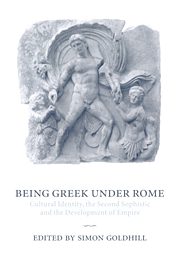Book contents
- Frontmatter
- Contents
- List of contributors
- Introduction: Setting an agenda: ‘Everything is Greece to the wise’
- 1 Subjected to Empire
- 1 From Megalopolis to Cosmopolis: Polybius, or there and back again
- 2 Mutilated messengers: body language in Josephus
- 3 Roman questions, Greek answers: Plutarch and the construction of identity
- II Intellectuals on the margins
- III Topography and the performance of culture
- List of works cited
- Index of major passages discussed
- General index
2 - Mutilated messengers: body language in Josephus
Published online by Cambridge University Press: 22 January 2010
- Frontmatter
- Contents
- List of contributors
- Introduction: Setting an agenda: ‘Everything is Greece to the wise’
- 1 Subjected to Empire
- 1 From Megalopolis to Cosmopolis: Polybius, or there and back again
- 2 Mutilated messengers: body language in Josephus
- 3 Roman questions, Greek answers: Plutarch and the construction of identity
- II Intellectuals on the margins
- III Topography and the performance of culture
- List of works cited
- Index of major passages discussed
- General index
Summary
Tourists through the ages who visit the Dead Sea have often been tempted to test its buoyancy by throwing something in. Vespasian inspected the site as a Roman general. He came, Josephus tells us, in the spirit of dispassionate enquiry (καθ ίστορίαν), and made trial of the water like everyone else. But he did not throw in an object, a bottle or a brick. He tossed in living human bodies with their hands tied behind their backs – bodies carefully selected for their known inability to swim. My goal in this paper is to use the evidence of Josephus to explore the mentality behind the choice of human bodies as buoyancy indicators in this recreational science experiment. It is really not explanation enough to invoke the notorious brutality of the Roman military, though Vespasian was in the process of subduing a rebel province at the time. Rather, what I am fishing for in these murky waters is some understanding of the semiotic context – of the ways the human body functioned as a signifier in that time and place. Josephus, as a bi-cultural first-hand observer, records a rich array of gestural evidence. His perceptions were filtered through a sensibility that was both Jewish and Romanized, and the tableaux he records (or invents) resonate to varying degrees with the stereotyped repertoire of self-expression traditional in both cultures. Separating out these two traditions is only a heuristic strategy, however, for ultimately their copresence in the narrative suggests an ongoing process of cultural accommodation.
- Type
- Chapter
- Information
- Being Greek under RomeCultural Identity, the Second Sophistic and the Development of Empire, pp. 50 - 85Publisher: Cambridge University PressPrint publication year: 2001
- 8
- Cited by

